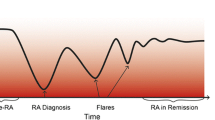Abstract
Background
Previous studies analyzing lipid profile in small cohorts of patients with rheumatic and inflammatory bowel diseases (IBD) treated with TNFα blockers showed conflicting results. We aim to evaluate the effect of anti-TNFα monoclonal antibodies, infliximab and adalimumab, on lipid profile in IBD patients followed up to 3 years.
Methods
Clinical charts of 128 consecutive IBD patients, who received at least three doses of infliximab or two doses of adalimumab, and with a clinical follow-up of at least 1 year, were retrospectively reviewed. Lipid profiles (total, HDL and LDL cholesterol, and triglycerides) before beginning the treatment and after 1 and 3 years of follow-up were collected. Multiple linear regression analysis was performed considering total cholesterol difference at basal time, 1 and 3 years as a dependent variable.
Results
There was not a statistically significant difference between pre- and post-treatment lipid profiles. However, the subgroup with normal-range total cholesterol level before anti-TNFα treatment (n = 82) showed a significant increase in total cholesterol after 1 and 3 years, and a significant increase in LDL cholesterol after 3 years. The subgroup with basal normal-range triglycerides showed a significant increase after 1 and 3 years of follow-up. Atherogenic index resulted significantly increased after 3 years of anti-TNFα treatment. Multivariate analysis showed no influence of age, gender, type of IBD, body mass index, or the presence of two or more cardiovascular risk factors.
Conclusions
No significant changes in lipid profile of IBD patients on anti-TNFα therapy were observed after 1 and 3 years of treatment.
Similar content being viewed by others
References
Popa C, Netea MG, Radstake T, et al. Influence of anti-tumour necrosis factor therapy on cardiovascular risk factors in patients with active rheumatoid arthritis. Ann Rheum Dis. 2005;64:303–305.
Popa C, van den Hoogen FH, Radstake TR, et al. Modulation of lipoprotein plasma concentrations during long-term anti-TNF therapy in patients with active rheumatoid arthritis. Ann Rheum Dis. 2007;66:1503–1507.
Spanakis E, Sidiropoulos P, Papadakis J, et al. Modest but sustained increase of serum high density lipoprotein cholesterol levels in patients with inflammatory arthritides treated with infliximab. J Rheumatol. 2006;33:2440–2446.
Antoniou C, Dessinioti C, Katsambas A, Stratigos AJ. Elevated triglyceride and cholesterol levels after intravenous antitumour necrosis factor-alpha therapy in a patient with psoriatic arthritis and psoriasis vulgaris. Br J Dermatol. 2007;156:1090–1091.
Castro KR, Aikawa NE, Saad CG, et al. Infliximab induces increase in triglyceride levels in psoriatic arthritis patients. Clin Dev Immunol. 2011;2011:352686.
Sappati Biyyani RS, Putka BS, Mullen KD. Dyslipidemia and lipoprotein profiles in patients with inflammatory bowel disease. J Clin Lipidol. 2010;4:478–482.
Koutroubakis IE, Oustamanolakis P, Malliaraki N, et al. Effects of tumor necrosis factor alpha inhibition with infliximab on lipid levels and insulin resistance in patients with inflammatory bowel disease. Eur J Gastroenterol Hepatol. 2009;21:283–288.
Parmentier-Decrucq E, Duhamel A, Ernst O, et al. Effects of infliximab therapy on abdominal fat and metabolic profile in patients with Crohn’s disease. Inflamm Bowel Dis. 2009;15:1476–1484.
Nunes T, Etchevers MJ, Merino O, et al. Does smoking influence Crohn’s disease in the biologic era? The TABACROHN study. Inflamm Bowel Dis. 2013;19:23–29.
Dorn SD, Sandler RS. Inflammatory bowel disease is not a risk factor for cardiovascular disease mortality: results from a systematic review and meta-analysis. Am J Gastroenterol. 2007;102:662–667.
Bewtra M, Kaiser LM, TenHave T, Lewis JD. Crohn’s disease and ulcerative colitis are associated with elevated standardized mortality ratios: a meta-analysis. Inflamm Bowel Dis. 2013;19:599–613.
Kristensen SL, Ahlehoff O, Lindhardsen J, et al. Disease activity in inflammatory bowel disease is associated with increased risk of myocardial infarction, stroke and cardiovascular death—a Danish nationwide cohort study. PLoS ONE. 2013;8:e56944.
Fumery M, Xiaocang C, Dauchet L, Gower-Rousseau C, Peyrin-Biroulet L, Colombel JF. Thromboembolic events and cardiovascular mortality in inflammatory bowel diseases: a meta-analysis of observational studies. J Crohns Colitis. 2014;8:469–479.
Singh S, Singh H, Loftus EV Jr, Pardi DS. Risk of cerebrovascular accidents and ischemic heart disease in patients with inflammatory bowel disease: a systematic review and meta-analysis. Clin Gastroenterol Hepatol. 2014;12:382–393.
Principi M, Mastrolonardo M, Scicchitano P, et al. Endothelial function and cardiovascular risk in active inflammatory bowel diseases. J Crohns Colitis. 2013;7:e427–e433.
Menchen L, Marin-Jimenez I, Arias-Salgado EG, et al. Matrix metalloproteinase 9 is involved in Crohn’s disease-associated platelet hyperactivation through the release of soluble CD40 ligand. Gut. 2009;58:920–928.
Nagahori M, Hyun SB, Totsuka T, et al. Prevalence of metabolic syndrome is comparable between inflammatory bowel disease patients and the general population. J Gastroenterol. 2010;45:1008–1013.
Tracey KJ, Wei H, Manogue KR, et al. Cachectin/tumor necrosis factor induces cachexia, anemia, and inflammation. J Exp Med. 1988;167:1211–1227.
Fong Y, Moldawer LL, Marano M, et al. Cachectin/TNF or IL-1 alpha induces cachexia with redistribution of body proteins. Am J Physiol. 1989;256:R659–R665.
Ericsson S, Eriksson M, Vitols S, Einarsson K, Berglund L, Angelin B. Influence of age on the metabolism of plasma low density lipoproteins in healthy males. J Clin Invest. 1991;87:591–596.
Ericsson S, Berglund L, Frostegard J, Einarsson K, Angelin B. The influence of age on low density lipoprotein metabolism: effects of cholestyramine treatment in young and old healthy male subjects. J Intern Med. 1997;242:329–337.
Acknowledgments
Supported by Grants from Spanish Ministry of Health (Instituto de Salud Carlos III-ISCIII-FIS 10/01912 and CIBEREHD) to LM.
Conflict of interest
The authors declare that they have no conflict of interest, financial or otherwise, with respect to this work.
Author information
Authors and Affiliations
Corresponding author
Rights and permissions
About this article
Cite this article
Miranda-Bautista, J., de Gracia-Fernández, C., López-Ibáñez, M. et al. Lipid Profile in Inflammatory Bowel Disease Patients on Anti-TNFα Therapy. Dig Dis Sci 60, 2130–2135 (2015). https://doi.org/10.1007/s10620-015-3577-0
Received:
Accepted:
Published:
Issue Date:
DOI: https://doi.org/10.1007/s10620-015-3577-0




